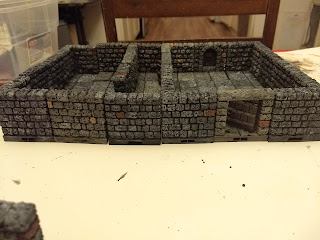After having a 3d printer for a while and getting deep into printing 3d dungeon tiles, I've finally gotten around to printing a pretty good number of them.
These are Fat Dragon Games brand Dragonlock 3d tiles. They are available on DriveThruRPG and they have a free set you can try. https://www.drivethrurpg.com/product/197128/DRAGONLOCK-Ultimate-Free-Sample-Set?cPath=587_24363
For a general cost breakdown, the printer I use cost $175 with shipping and required assembly.
https://www.gearbest.com/3d-printers-3d-printer-kits/pp_337314.html?wid=1433363¤cy=USD&vip=4264393&gclid=CjwKCAjw5ZPcBRBkEiwA-avvk-L2AlIF-Gxq7fnZD7SX_QnUwC6c_b7GnZBloRLMB7Um2sS-wyOmMhoCJPkQAvD_BwE
Printer filament is about $20 per 1kg spool.
https://www.amazon.com/HATCHBOX-3D-Filament-Dimensional-Accuracy/dp/B00J0GMMP6/ref=sr_1_3/130-5385302-1079852?ie=UTF8&qid=1535471483&sr=8-3&keywords=filament+pla+hatchbox
The models are typically $9.99 per file set.
https://www.drivethrurpg.com/product/166074/DRAGONLOCK-Ultimate-Dungeon-Starter-Set?src=hottest_filtered
With these things together, not accounting for time and labor on my part, I think tiles cost about 80 cents per piece.
None of my 3d tile models are as high quality or durable as Dwarven Forge's top of the line dungeon tiles, but the cost and ability to produce what I want makes up for that, to me. The biggest thing I want out of dungeon tiles is the ability to quickly create fun 3d setups for Dungeons and Dragons with a set of tools that won't be harmed when my kids play with them.
Previous to this, I've done a lot of projects with cardboard and foam but these haven't held up well with time. The 3d printed tiles combine higher durability with low individual costs to keep things reasonable for me.
These are Fat Dragon Games brand Dragonlock 3d tiles. They are available on DriveThruRPG and they have a free set you can try. https://www.drivethrurpg.com/product/197128/DRAGONLOCK-Ultimate-Free-Sample-Set?cPath=587_24363
For a general cost breakdown, the printer I use cost $175 with shipping and required assembly.
https://www.gearbest.com/3d-printers-3d-printer-kits/pp_337314.html?wid=1433363¤cy=USD&vip=4264393&gclid=CjwKCAjw5ZPcBRBkEiwA-avvk-L2AlIF-Gxq7fnZD7SX_QnUwC6c_b7GnZBloRLMB7Um2sS-wyOmMhoCJPkQAvD_BwE
Printer filament is about $20 per 1kg spool.
https://www.amazon.com/HATCHBOX-3D-Filament-Dimensional-Accuracy/dp/B00J0GMMP6/ref=sr_1_3/130-5385302-1079852?ie=UTF8&qid=1535471483&sr=8-3&keywords=filament+pla+hatchbox
The models are typically $9.99 per file set.
https://www.drivethrurpg.com/product/166074/DRAGONLOCK-Ultimate-Dungeon-Starter-Set?src=hottest_filtered
With these things together, not accounting for time and labor on my part, I think tiles cost about 80 cents per piece.
Previous to this, I've done a lot of projects with cardboard and foam but these haven't held up well with time. The 3d printed tiles combine higher durability with low individual costs to keep things reasonable for me.





Comments
Post a Comment